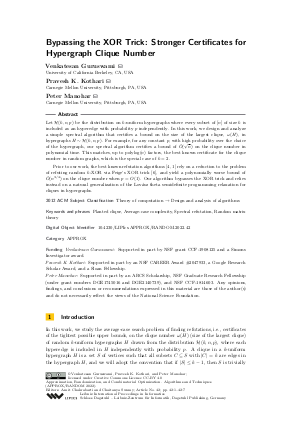Bypassing the XOR Trick: Stronger Certificates for Hypergraph Clique Number
Authors Venkatesan Guruswami, Pravesh K. Kothari, Peter Manohar
-
Part of:
Volume:
Approximation, Randomization, and Combinatorial Optimization. Algorithms and Techniques (APPROX/RANDOM 2022)
Part of: Series: Leibniz International Proceedings in Informatics (LIPIcs)
Part of: Conference: International Conference on Randomization and Computation (RANDOM)
Part of: Conference: International Conference on Approximation Algorithms for Combinatorial Optimization Problems (APPROX) - License:
 Creative Commons Attribution 4.0 International license
Creative Commons Attribution 4.0 International license
- Publication Date: 2022-09-15
File

PDF
LIPIcs.APPROX-RANDOM.2022.42.pdf
- Filesize: 0.57 MB
- 7 pages
Document Identifiers
Subject Classification
ACM Subject Classification
- Theory of computation → Design and analysis of algorithms
Keywords
- Planted clique
- Average-case complexity
- Spectral refutation
- Random matrix theory
Metrics
- Access Statistics
-
Total Accesses (updated on a weekly basis)
0PDF Downloads0Metadata Views
Abstract
Let H(k,n,p) be the distribution on k-uniform hypergraphs where every subset of [n] of size k is included as an hyperedge with probability p independently. In this work, we design and analyze a simple spectral algorithm that certifies a bound on the size of the largest clique, ω(H), in hypergraphs H ∼ H(k,n,p). For example, for any constant p, with high probability over the choice of the hypergraph, our spectral algorithm certifies a bound of Õ(√n) on the clique number in polynomial time. This matches, up to polylog(n) factors, the best known certificate for the clique number in random graphs, which is the special case of k = 2.
Prior to our work, the best known refutation algorithms [Amin Coja-Oghlan et al., 2004; Sarah R. Allen et al., 2015] rely on a reduction to the problem of refuting random k-XOR via Feige’s XOR trick [Uriel Feige, 2002], and yield a polynomially worse bound of Õ(n^{3/4}) on the clique number when p = O(1). Our algorithm bypasses the XOR trick and relies instead on a natural generalization of the Lovász theta semidefinite programming relaxation for cliques in hypergraphs.
Cite As Get BibTex
Venkatesan Guruswami, Pravesh K. Kothari, and Peter Manohar. Bypassing the XOR Trick: Stronger Certificates for Hypergraph Clique Number. In Approximation, Randomization, and Combinatorial Optimization. Algorithms and Techniques (APPROX/RANDOM 2022). Leibniz International Proceedings in Informatics (LIPIcs), Volume 245, pp. 42:1-42:7, Schloss Dagstuhl – Leibniz-Zentrum für Informatik (2022)
https://doi.org/10.4230/LIPIcs.APPROX/RANDOM.2022.42
BibTex
@InProceedings{guruswami_et_al:LIPIcs.APPROX/RANDOM.2022.42,
author = {Guruswami, Venkatesan and Kothari, Pravesh K. and Manohar, Peter},
title = {{Bypassing the XOR Trick: Stronger Certificates for Hypergraph Clique Number}},
booktitle = {Approximation, Randomization, and Combinatorial Optimization. Algorithms and Techniques (APPROX/RANDOM 2022)},
pages = {42:1--42:7},
series = {Leibniz International Proceedings in Informatics (LIPIcs)},
ISBN = {978-3-95977-249-5},
ISSN = {1868-8969},
year = {2022},
volume = {245},
editor = {Chakrabarti, Amit and Swamy, Chaitanya},
publisher = {Schloss Dagstuhl -- Leibniz-Zentrum f{\"u}r Informatik},
address = {Dagstuhl, Germany},
URL = {https://drops.dagstuhl.de/entities/document/10.4230/LIPIcs.APPROX/RANDOM.2022.42},
URN = {urn:nbn:de:0030-drops-171642},
doi = {10.4230/LIPIcs.APPROX/RANDOM.2022.42},
annote = {Keywords: Planted clique, Average-case complexity, Spectral refutation, Random matrix theory}
}
Author Details
Funding
- Guruswami, Venkatesan: Supported in part by NSF grant CCF-1908125 and a Simons Investigator award.
- Kothari, Pravesh K.: Supported in part by an NSF CAREER Award #2047933, a Google Research Scholar Award, and a Sloan Fellowship.
- Manohar, Peter: Supported in part by an ARCS Scholarship, NSF Graduate Research Fellowship (under grant numbers DGE1745016 and DGE2140739), and NSF CCF-1814603. Any opinions, findings, and conclusions or recommendations expressed in this material are those of the author(s) and do not necessarily reflect the views of the National Science Foundation.
References
-
Sarah R. Allen, Ryan O'Donnell, and David Witmer. How to refute a random CSP. In Proceedings of the 56th Annual IEEE Symposium on Foundations of Computer Science, pages 689-708, 2015.

-
Noga Alon, Michael Krivelevich, and Benny Sudakov. Finding a large hidden clique in a random graph. In SODA, pages 594-598. ACM/SIAM, 1998.

-
Boaz Barak, Samuel B. Hopkins, Jonathan A. Kelner, Pravesh Kothari, Ankur Moitra, and Aaron Potechin. A nearly tight sum-of-squares lower bound for the planted clique problem. In FOCS, pages 428-437. IEEE Computer Society, 2016.

-
Amin Coja-Oghlan, Andreas Goerdt, and André Lanka. Strong refutation heuristics for random k-sat. In Approximation, Randomization, and Combinatorial Optimization, Algorithms and Techniques, volume 3122 of Lecture Notes in Computer Science, pages 310-321. Springer, 2004.

-
Yash Deshpande and Andrea Montanari. Improved sum-of-squares lower bounds for hidden clique and hidden submatrix problems. In COLT, volume 40 of JMLR Workshop and Conference Proceedings, pages 523-562. JMLR.org, 2015.

-
Uriel Feige. Relations between average case complexity and approximation complexity. In STOC, pages 534-543. ACM, 2002.

-
Uriel Feige and Robert Krauthgamer. Finding and certifying a large hidden clique in a semirandom graph. Random Struct. Algorithms, 16(2):195-208, 2000.

-
Uriel Feige and Robert Krauthgamer. The probable value of the lovász-schrijver relaxations for maximum independent set. SIAM J. Comput., 32(2):345-370, 2003.

-
Samuel B. Hopkins, Pravesh K. Kothari, and Aaron Potechin. Sos and planted clique: Tight analysis of MPW moments at all degrees and an optimal lower bound at degree four. CoRR, abs/1507.05230, 2015.

-
Mark Jerrum. Large cliques elude the metropolis process. Random Struct. Algorithms, 3(4):347-360, 1992.

-
Michael Krivelevich and Benny Sudakov. The chromatic numbers of random hypergraphs. Random Struct. Algorithms, 12(4):381-403, 1998.

-
Ludek Kucera. Expected complexity of graph partitioning problems. Discrete Applied Mathematics, 57(2-3):193-212, 1995.

-
Raghu Meka, Aaron Potechin, and Avi Wigderson. Sum-of-squares lower bounds for planted clique. In STOC, pages 87-96. ACM, 2015.

-
Prasad Raghavendra and Tselil Schramm. Tight lower bounds for planted clique in the degree-4 SOS program. CoRR, abs/1507.05136, 2015.

- Joel A. Tropp. User-friendly tail bounds for sums of random matrices. Foundations of Computational Mathematics, 12(4):389-434, August 2012. URL: https://doi.org/10.1007/s10208-011-9099-z.
